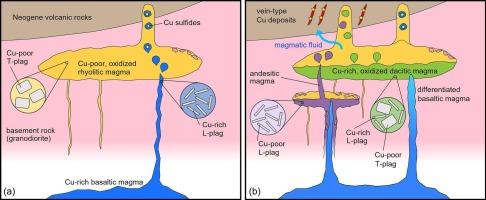岩浆混合对热液铜成矿作用的贡献:来自日本秋田荒川地区的证据
IF 3.6
2区 地球科学
Q1 GEOLOGY
引用次数: 0
摘要
在太平洋板块俯冲形成的火山弧——日本弧东北部,分布着大量新近系脉状铜矿床。这些矿床与邻近的中新世和上新世长英质侵入体伴生,构成了日本弧区内最大的铜成矿省。Arakawa铜矿是该区典型的脉状铜矿床,其附近的成矿侵入体由微花岗岩和流纹岩组成,包括深灰色英长质—安山岩包体和深绿色玄武岩包体。除了含硫化物的玄武岩包体外,这些火成岩是在氧化条件下形成的,位于SSO缓冲带上方或附近,含有极少量(1 - 3ppm)的铜。这些火成岩中斜长石晶体的Cu含量≤17.9 ppm,在Cu - An%空间中呈现出两个明显的簇状结构:一个在An <; 60%时Cu含量≤5.1 ppm,另一个在An≈89%时Cu含量从2.8 ppm增加到17.9 ppm (An≈14%)。前者产于流纹岩、微花岗质侵入岩和安山岩包体中,后者产于玄武岩包体中;太平洋飞地包含这两种组合。贫铜流纹岩岩浆与富铜分异玄武岩岩浆混合形成的英质包裹体。根据早结晶斜长石晶体的Cu含量和已报道的斜长石-熔体分配系数计算了两种岩浆的初始Cu含量。与观察到的全岩铜含量比较,可以估计结晶过程中岩浆释放的铜量。岩浆包体的特征表明,岩浆包体是由富铜玄武岩岩浆经过结晶分异和混合作用形成的中成分岩浆。推断这些岩浆为形成Arakawa铜矿的岩浆热液系统提供了铜。本文章由计算机程序翻译,如有差异,请以英文原文为准。

Contribution of magma mixing to hydrothermal Cu mineralization: Evidence from the Arakawa area, Akita, Japan
A large number of Neogene vein-type Cu deposits are distributed in the Northeast Japan Arc, a volcanic arc formed by the subduction of the Pacific Plate. These deposits, which are associated with neighboring Miocene and Pliocene felsic intrusions, constitute the largest Cu metallogenic province in the Japan Arc. Ore-related intrusions near the Arakawa Cu deposit, which is a typical vein-type Cu deposit in the area, are composed of microgranite and rhyolite, which include dark-gray dacitic to andesitic enclaves and dark-green basaltic enclaves. Except for the sulfide-bearing basaltic enclaves, these igneous rocks formed under oxidizing conditions above or near the SSO buffer and contain very small amounts (1–3 ppm) of Cu. Plagioclase crystals in these igneous rocks contain ≤17.9 ppm Cu and show two distinct clusters in Cu–An% space: one with ≤5.1 ppm Cu at An <60 %, and another showing an increasing trend from 2.8 (at An ≈ 89 %) to 17.9 ppm Cu (at An ≈ 14 %). The former assemblage occurs in rhyolitic and microgranitic intrusive rocks and in andesitic enclaves, while the latter is found in basaltic enclaves; dacitic enclaves contain both assemblages. The dacitic enclaves formed by mixing a Cu-poor rhyolitic magma with a Cu-rich differentiated basaltic magma. The initial Cu contents of these two magmas were calculated using the Cu contents of early-crystallizing plagioclase crystals and reported plagioclase–melt partition coefficients. Comparison with the observed whole-rock Cu contents allowed estimation of the amounts of Cu released from the magmas during crystallization. The characteristics of the magmatic enclaves indicate the presence of intermediate-composition magmas formed after differentiation by crystallization and by mixing with a Cu-rich basaltic magma. These magmas are inferred to have supplied Cu to the magmatic–hydrothermal system that formed the Arakawa Cu deposit.
求助全文
通过发布文献求助,成功后即可免费获取论文全文。
去求助
来源期刊

Ore Geology Reviews
地学-地质学
CiteScore
6.50
自引率
27.30%
发文量
546
审稿时长
22.9 weeks
期刊介绍:
Ore Geology Reviews aims to familiarize all earth scientists with recent advances in a number of interconnected disciplines related to the study of, and search for, ore deposits. The reviews range from brief to longer contributions, but the journal preferentially publishes manuscripts that fill the niche between the commonly shorter journal articles and the comprehensive book coverages, and thus has a special appeal to many authors and readers.
 求助内容:
求助内容: 应助结果提醒方式:
应助结果提醒方式:


